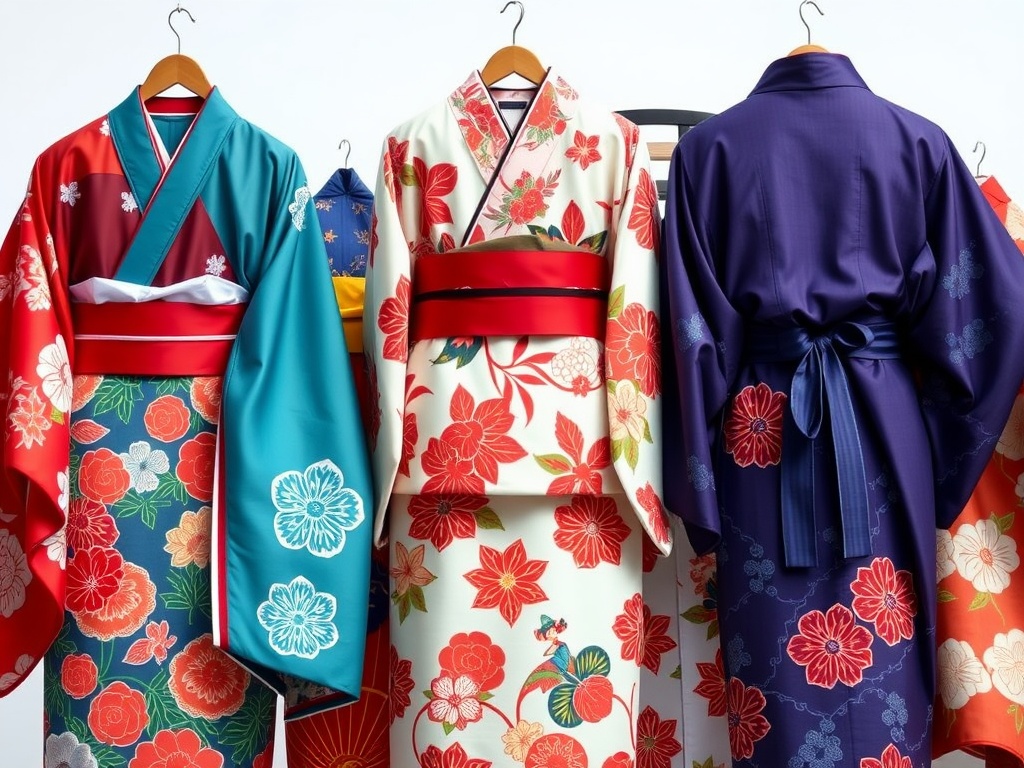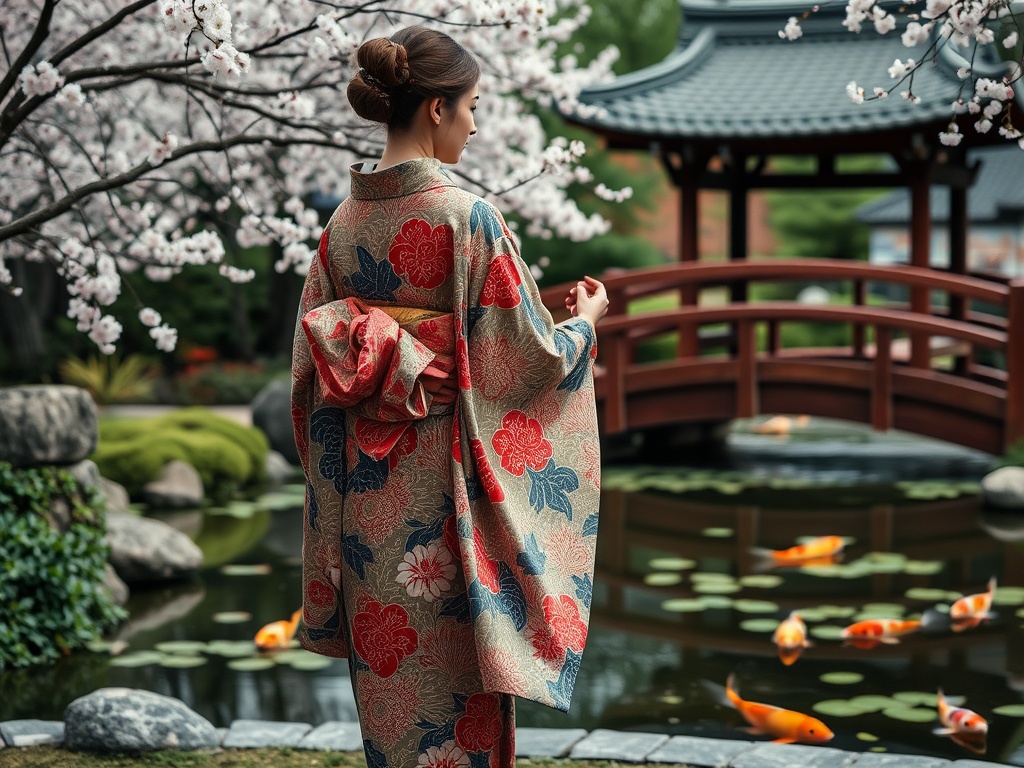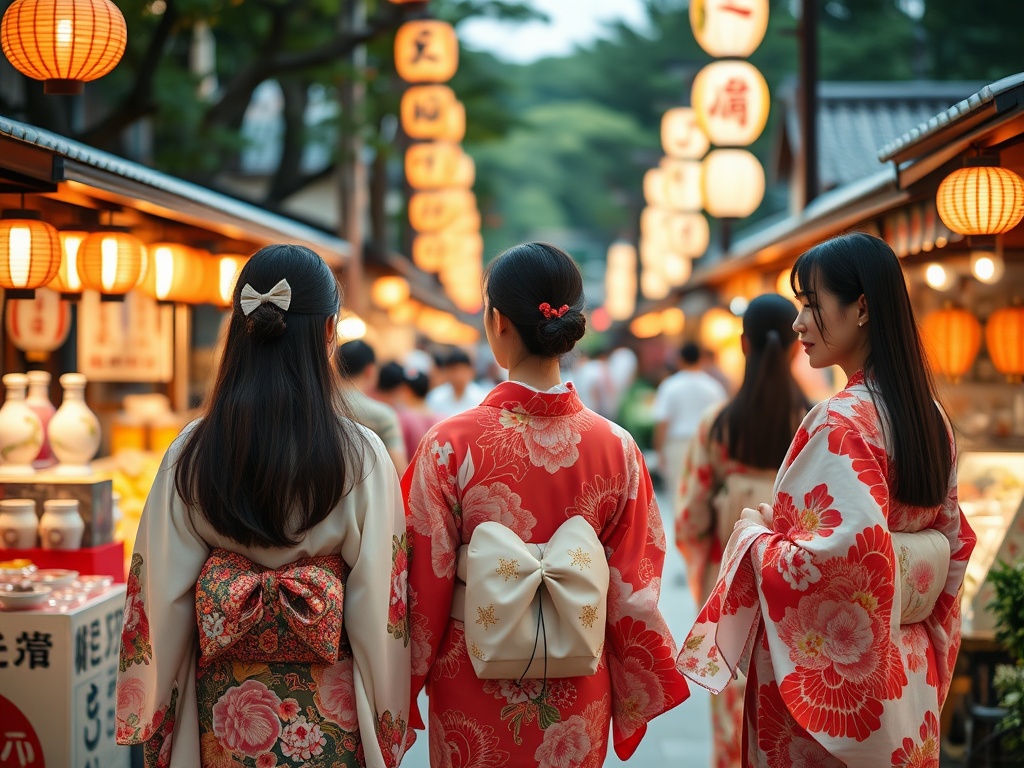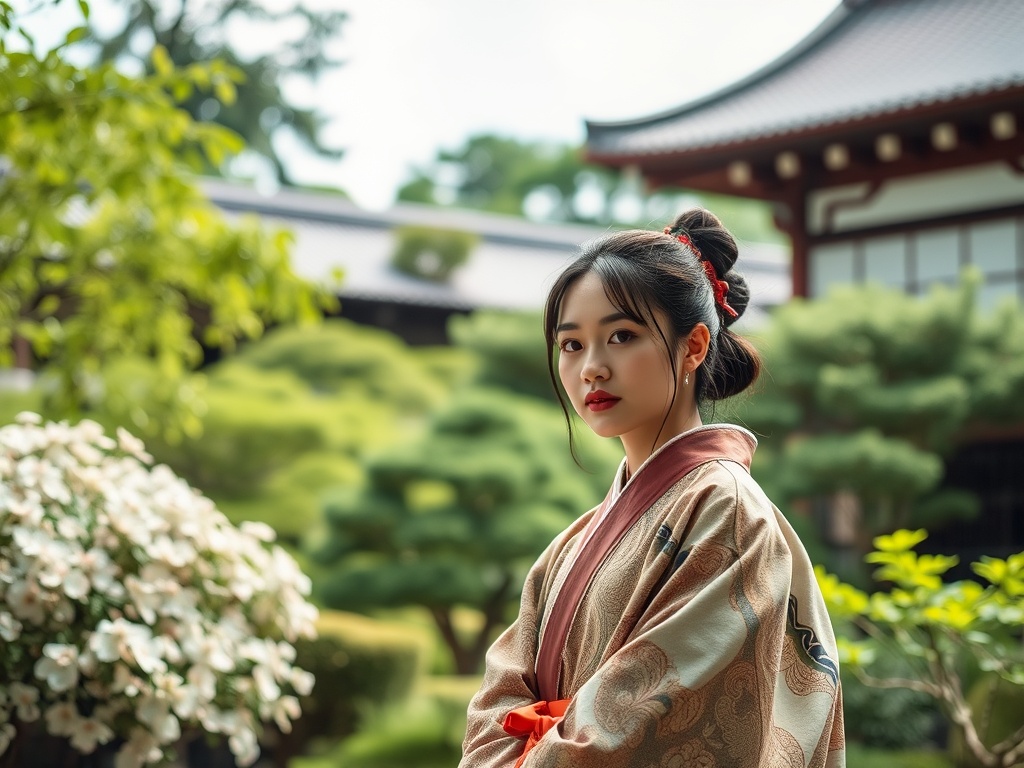The Art of Kimono: A Timeless Fashion Journey
Win a Free Trip to Japan!
Experience cherry blossoms and ancient temples
The kimono is not merely a piece of clothing; it is a rich tapestry of history, art, and culture woven together over centuries. This iconic garment, with its elegant folds and vibrant patterns, tells a story of Japan’s past and continues to be a symbol of its enduring traditions. For travel and tourism enthusiasts eager to explore Japan’s cultural heritage, understanding the nuances of the kimono is akin to embarking on a fascinating journey through time.
The kimono comes in a variety of styles, each suited for different occasions. The choice of kimono depends on the wearer’s age, the formality of the event, and the season. Here’s a quick guide to help you recognize the different types:
- Furisode: Often worn by young, unmarried women, this kimono is distinguished by its long sleeves and vibrant colors, typically donned during special ceremonies.
- Yukata: A lightweight, casual kimono, perfect for summer festivals and onsens (hot springs). Its simple design makes it ideal for casual outings.
- Tomosode: A more formal kimono with shorter sleeves, often worn by married women during weddings or formal events, featuring elegant, subdued patterns.
- Hakama: Traditionally worn by men, this kimono is paired with wide-legged trousers and is often seen at graduation ceremonies or martial arts events.
The making of a kimono is a highly skilled art form, involving meticulous craftsmanship and an eye for detail. From the handwoven silk to the intricate dyeing techniques, every element of the kimono reflects the dedication and artistry of its maker.
Fabric and Design: Kimono fabrics are typically made from silk, cotton, or synthetic materials. The designs are often inspired by nature, with motifs of cherry blossoms, cranes, and bamboo being particularly popular.
Color Symbolism: Colors play a significant role in kimono design, each carrying its own symbolism. For instance, red may symbolize passion and joy, while blue often represents tranquility and fidelity.
Wearing a kimono is not just about fashion; it’s about embracing a piece of Japan’s soul, a tradition passed down through generations. Whether attending a tea ceremony or exploring a vibrant festival, donning a kimono allows travelers to connect deeply with Japan’s cultural landscape.
Yukata Magic: Embrace the Summer Festival Spirit
For travel and tourism enthusiasts venturing into the heart of Japan, discovering the allure of the yukata opens up a world of cultural immersion, especially during the vibrant summer festivals. Unlike the more formal kimono, the yukata invites wearers to experience the essence of traditional Japanese festivities with a touch of casual elegance. As the sun sets and the lanterns light up, the sight of people in colorful yukatas mingling amidst the festivities is truly a magical experience.
One of the most captivating aspects of the yukata is its ability to transform an ordinary summer evening into an extraordinary cultural celebration. The yukata, typically crafted from breathable cotton, is designed to keep you cool and comfortable, making it the perfect attire for attending summer festivals, known as matsuri. Whether you’re savoring street food or watching a dazzling fireworks display, the yukata serves as a bridge, connecting you to the jubilant spirit of the season.
The selection of a yukata often reflects personal taste as well as seasonal themes. Traditionally, yukatas feature vibrant floral patterns such as cherry blossoms or hydrangeas, symbolizing the beauty of nature in full bloom. When choosing a yukata, consider hues that resonate with the festival season; for instance, soft pastels can evoke the serene beauty of summer evenings, while bold colors make a striking statement against the backdrop of festival lights.
Wearing a yukata involves more than simply donning the garment; it is an art that combines style with cultural etiquette. The yukata is wrapped around the body, ensuring the left side overlaps the right—a practice steeped in tradition and respect. The ensemble is completed with an obi, a sash that not only secures the yukata but also adds a touch of elegance with its intricate knots and designs. As you stroll through the festival, every fold and drape of the yukata tells a story of time-honored customs and artistic expression.
Samurai Chic: The Allure of Traditional Hakama
For those seeking to delve deeper into Japan’s rich sartorial history, the traditional hakama offers a unique glimpse into the world of the samurai. This distinctive attire, characterized by its wide-legged trousers and flowing silhouette, embodies the spirit of honor, discipline, and elegance. Beyond its historical roots, the hakama has evolved to become a symbol of sophistication, blending seamlessly into modern ceremonial occasions.
Inspired by the graceful movements of martial arts and the formal settings of traditional Japanese ceremonies, the hakama holds a special place in Japan’s cultural tapestry. It serves as a bridge between the past and the present, allowing wearers to experience a slice of samurai life while participating in contemporary events. Whether you’re attending a tea ceremony or witnessing a martial arts demonstration, donning a hakama transports you to a realm where tradition meets modernity.
The hakama, originally worn by samurai warriors, has a rich history that reflects Japan’s social and cultural evolution. In the feudal era, it was a practical garment that offered both protection and mobility. Today, the hakama is cherished for its timeless beauty and is often seen at graduation ceremonies, weddings, and other formal events. Its enduring appeal lies in its ability to convey a sense of dignity and poise.
Modern fashion enthusiasts are increasingly drawn to the hakama for its versatility. It complements a range of styles, from traditional to contemporary, making it a popular choice for those seeking to make a bold fashion statement. With its unique design and historical roots, the hakama embodies a fusion of tradition and innovation.
Wearing a hakama involves understanding its intricate design and respecting the cultural nuances associated with it. The garment is typically worn over a kimono, with pleats carefully aligned to enhance the wearer’s posture and movement. The tying of the obi, or sash, is an art form in itself, requiring skill and precision to achieve the desired look.
Mastering the art of wearing a hakama is akin to embracing a piece of Japan’s cultural heritage. For those new to this traditional attire, it offers an opportunity to explore the elegance and discipline that define Japanese fashion. Whether you’re a history buff or a fashion aficionado, the hakama invites you to immerse yourself in the world of samurai chic, where every fold and pleat tells a story of tradition and grace.
Geisha Elegance: Unveiling the Mystique of Maiko Attire
Among the many facets of Japan’s rich cultural heritage, the world of geishas and their apprentices, known as maiko, stands out with its enigmatic allure. For travel and tourism enthusiasts eager to delve into the intricate traditions of Japan, exploring the attire of a maiko offers a captivating glimpse into a realm of artistry and elegance. Stepping into the shoes of a maiko means embarking on a journey where every piece of clothing and every accessory tells a story of cultural sophistication.
The attire of a maiko is a celebration of youthful exuberance and vibrant artistry. Unlike the more subtle and refined garments of a full-fledged geisha, a maiko’s outfit is characterized by its bright colors and elaborate designs. The long-sleeved kimono, often adorned with intricate patterns of flowers and seasonal motifs, reflects not only the maiko’s status as an apprentice but also the beauty of nature in all its splendor.
One of the most striking features of a maiko’s attire is the obi, a wide sash tied at the back with an elaborate knot that cascades down the back, symbolizing her journey in the traditional arts. Complementing the kimono, the maiko wears okobo, tall wooden sandals that create a distinctive clacking sound as she walks, adding an auditory element to her graceful appearance.
Every aspect of the maiko’s attire is steeped in symbolism, reflecting her status and the cultural values she represents. The vibrant red collar of her kimono is a symbol of youth and vitality, while the elaborate hair ornaments, or kanzashi, change according to the seasons, echoing the deep connection between Japanese tradition and the natural world.
For those interested in cultural expression through fashion, understanding the nuances of maiko attire offers a deeper appreciation of how clothing can convey identity, status, and tradition. The maiko’s transformation into a geisha is marked not just by her skills in the arts but also by a shift in her attire towards more subdued elegance, reflecting her maturity and mastery.
Stepping into the world of maiko attire allows travelers to witness firsthand the dedication to beauty and tradition that defines this unique aspect of Japanese culture. Whether attending a traditional tea ceremony or exploring the historic streets of Kyoto, experiencing the elegance of maiko attire brings Japan’s cultural history to life in vivid color and graceful form.
Modern Meets Tradition: The Evolution of Japanese Street Kimono
As the cultural tapestry of Japan continues to weave its way into the modern era, the kimono is experiencing a renaissance in the vibrant streets of Japan’s urban centers. Infused with contemporary flair while retaining its traditional roots, the street kimono represents a captivating fusion of past and present. For travel and tourism enthusiasts, exploring this evolution offers a unique insight into how Japanese fashion adapts and thrives in modern-day society, echoing the country’s ability to honor heritage while embracing innovation.
In recent years, the street kimono has emerged as a popular fashion statement among Japan’s younger generations. This trend sees the traditional garment reimagined with bold patterns, unconventional fabrics, and creative accessories, making it a staple in the wardrobes of fashion-forward individuals. The street kimono is a testament to the adaptability of Japanese culture, showcasing how traditional attire can seamlessly blend with the eclectic styles of urban fashion.
Fashion districts in cities like Tokyo and Osaka have become hubs for this cultural amalgamation, where kimono boutiques and vintage shops offer a diverse array of street kimono options. These areas provide a playground for fashion enthusiasts eager to experiment with this dynamic style, offering a canvas to express individuality while paying homage to tradition.
Creating a street kimono look involves combining traditional elements with modern touches, resulting in a unique style that stands out in the bustling cityscape. Here’s a breakdown of key components that typically make up a street kimono ensemble:
- Kimono Jacket: A shorter, more casual version of the traditional kimono, often featuring vibrant prints and bold colors.
- Modern Obi: While still serving as a waist sash, the street kimono obi often includes contemporary designs and materials, adding a fresh twist to the classic look.
- Footwear: Sneakers or platform shoes are commonly paired with street kimonos, providing comfort and a modern edge.
- Accessories: Hats, bags, and jewelry are used to personalize the outfit, integrating current fashion trends into the traditional silhouette.
For travelers eager to immerse themselves in the street kimono scene, participating in fashion tours or workshops can offer a hands-on experience. These activities provide insights into the design process behind modern kimonos and allow participants to create their own unique ensembles. Additionally, attending fashion festivals in Japan, such as Tokyo Fashion Week, can provide a glimpse into the cutting-edge trends and how the street kimono continues to evolve.
Embracing the street kimono trend offers travelers a chance to witness firsthand the harmonious blend of tradition and modernity in Japanese fashion. It’s a journey through style that celebrates the enduring legacy of the kimono while highlighting Japan’s innovative spirit.
Obi Wonders: The Secret Language of Sashes
The obi, a sash that elegantly wraps around the kimono, is more than just a functional garment piece; it is an expression of artistry and symbolism. For travel and tourism enthusiasts venturing into the world of traditional Japanese fashion, uncovering the secrets of the obi reveals a complex language of style, status, and cultural history. Whether you’re walking through the bustling streets of Tokyo or attending a serene tea ceremony, understanding the nuances of the obi enriches your cultural journey through Japan.
The creation of an obi is a meticulous process, steeped in tradition and requiring a keen eye for detail. These sashes are often made from luxurious silk or brocade, showcasing intricate patterns that range from delicate floral motifs to bold geometric designs. Each obi is a masterpiece in itself, a testament to the skills of artisans who weave stories into fabric. As you explore Japan’s cultural tapestry, you’ll find that the obi is not just a fashion statement but a canvas of cultural expression, reflecting the wearer’s personality and the occasion’s significance.
Beyond its decorative allure, the obi speaks a silent language through its various tying styles. Each knot and drape tells a story, conveying messages about the wearer’s age, marital status, and even the formality of the event. For instance, the taiko musubi is a popular knot for formal events, symbolizing elegance and sophistication, while the more casual bunko musubi reflects a youthful and playful spirit. As you delve deeper into the art of wearing a kimono, mastering the different obi styles becomes a journey of discovery, allowing you to engage with Japan’s rich cultural heritage on a personal level.
For those eager to immerse themselves in this traditional art, workshops and cultural experiences are available across Japan, offering hands-on opportunities to learn the intricate techniques of obi tying. Engaging in these activities not only enhances your understanding of Japanese fashion but also provides a memorable connection to the artistry and tradition that define the kimono ensemble.



